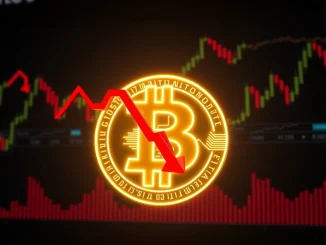
Crypto users, are you paying attention to the latest security threats? A recent report has surfaced, shedding light on the persistent activities of the Bybit hackers. It seems these cybercriminals, responsible for a past security incident, are back in action, and this time, blockchain security firm Beosin is raising the alarm. Let’s dive into the details of how these hackers are moving stolen funds and what it means for the wider crypto space.
Bybit Hackers Resume Asset Transfers: What’s Happening?
According to a recent announcement from Beosin on X (formerly Twitter), the Bybit hackers have once again initiated asset transfers. Starting at 00:58 UTC on February 24th, these illicit movements indicate a continued effort to launder the proceeds from their cyberattack. This development is not just a minor hiccup; it’s a stark reminder of the ongoing challenges in cryptocurrency security and the sophistication of cybercriminals targeting digital assets.
Here’s a breakdown of the key points from Beosin’s report:
- Resumption of Activity: Bybit hackers have restarted transferring assets after a period of relative inactivity.
- Time of Activity: The transfers began at 00:58 UTC on February 24th.
- Source of Information: The report comes from Beosin, a reputable blockchain security company.
- Implication: This signifies that the threat from these hackers is not neutralized and remains a concern for Bybit users and the crypto community at large.
Decoding the Crypto Laundering Techniques: A Stabilized Method
What’s particularly concerning, and perhaps insightful, is Beosin’s observation about the hackers’ crypto laundering methods. The report suggests that their approach is becoming more refined and “stabilizing.” This implies they are honing their techniques to effectively obscure the origin of the stolen funds and make them harder to trace. Understanding these methods is crucial to combatting such illicit activities in the future.
Let’s break down the stabilized crypto laundering process identified by Beosin:
- THORChain Utilization: The hackers are primarily using THORChain, a decentralized cross-chain liquidity protocol, to initiate the laundering process. THORChain’s ability to facilitate swaps between different blockchains makes it a valuable tool for those seeking to obfuscate transaction trails.
- Bitcoin Network as a Conduit: Assets are transferred to the Bitcoin (BTC) network after being processed through THORChain. Bitcoin, being the oldest and most widely used cryptocurrency, provides a degree of liquidity and anonymity that can be exploited in laundering schemes.
- DAI Stablecoin Swap on OKX DEX: From the Bitcoin network, the assets are then swapped for DAI, a stablecoin pegged to the U.S. dollar, on the OKX decentralized exchange (DEX). Stablecoins offer a way to convert volatile cryptocurrencies into assets with a more stable value, potentially simplifying the next steps in the laundering process.
- Distribution via eXch Platform: Finally, the DAI obtained from OKX is moved to the eXch platform for further distribution. The “further distribution” aspect suggests the hackers are likely breaking down the large sums into smaller, less conspicuous amounts, making them even harder to track and recover.
Beosin Report: A Beacon of Transparency in Crypto Security
The role of Beosin in uncovering and reporting these asset transfers is paramount. Blockchain security companies like Beosin play a vital role in the cryptocurrency ecosystem. They act as watchdogs, scrutinizing transactions, identifying vulnerabilities, and alerting the community to potential threats. Beosin‘s proactive reporting helps to:
- Increase Transparency: By publicly sharing their findings, Beosin contributes to greater transparency within the often opaque world of cryptocurrency transactions.
- Inform Stakeholders: Their reports inform exchanges, users, and other stakeholders about ongoing security risks, enabling them to take necessary precautions.
- Aid in Investigations: The detailed analysis provided by security firms like Beosin can be invaluable for law enforcement and asset recovery efforts.
- Promote Security Awareness: Ultimately, such reports raise awareness about the importance of robust security practices in the cryptocurrency space.
The Role of THORChain in Facilitating Asset Transfers
The mention of THORChain in the hackers’ methodology is noteworthy. THORChain is designed to enable cross-chain token swaps in a decentralized and permissionless manner. While this technology is intended for legitimate purposes, such as facilitating seamless trading between different blockchains, it can unfortunately be exploited for illicit activities like crypto laundering.
Why might hackers choose THORChain?
- Cross-Chain Functionality: THORChain excels at moving assets between different blockchains, a crucial feature for laundering funds that might initially be held on a specific network.
- Decentralization: As a decentralized protocol, THORChain may offer a perceived layer of anonymity and reduced regulatory oversight compared to centralized exchanges.
- Liquidity: THORChain aims to provide deep liquidity for various cryptocurrency pairs, making it easier to swap large amounts of assets.
It’s important to emphasize that the issue here is not with THORChain itself, but rather the misuse of its technology by malicious actors. Decentralized tools, while empowering, can be a double-edged sword.
Bitcoin, DAI, OKX, and eXch: Tracing the Asset Transfers Path
The subsequent steps in the asset transfers highlight a calculated approach to money laundering. Let’s examine each stage:
| Platform/Cryptocurrency | Role in Laundering | Rationale |
|---|---|---|
| Bitcoin (BTC) Network | Transfer conduit | High liquidity, widespread acceptance, some level of anonymity. |
| DAI Stablecoin | Value stabilization | Pegged to USD, reduces volatility, easier to convert to fiat or other assets later. |
| OKX DEX | Swap platform | Decentralized exchange, potentially less stringent KYC/AML compared to centralized platforms (though this is changing). |
| eXch Platform | Distribution point | Likely used to further disperse funds, making them harder to track in bulk. Specific details about eXch’s nature and jurisdiction would be needed for further analysis. |
This multi-stage process illustrates the lengths to which cybercriminals go to clean their ill-gotten gains. It underscores the need for sophisticated tracking and analysis tools, as well as international cooperation to combat crypto laundering effectively.
What Does This Mean for Bybit Users and Crypto Security?
The resumption of asset transfers by the Bybit hackers serves as a critical reminder of the ever-present threats in the cryptocurrency world. For Bybit users specifically, and the broader crypto community, this news should prompt increased vigilance and a renewed focus on security best practices.
Actionable Insights:
- 加强安全措施 (Strengthen Security Measures): Users should reinforce their personal security practices, including strong passwords, two-factor authentication (2FA), and being wary of phishing attempts.
- 交易所警惕 (Exchange Vigilance): Cryptocurrency exchanges, including Bybit, must continuously enhance their security protocols and monitoring systems to detect and prevent illicit asset transfers.
- 监管合作 (Regulatory Cooperation): Increased collaboration between exchanges, security firms like Beosin, and regulatory bodies is crucial to track, intercept, and ultimately deter crypto laundering activities.
- 技术创新 (Technological Innovation): Ongoing development and deployment of advanced blockchain analytics tools are needed to stay ahead of increasingly sophisticated crypto laundering techniques.
Conclusion: An Urgent Call for Enhanced Crypto Security
The news of Bybit hackers resuming asset transfers and refining their crypto laundering methods is a serious wake-up call for the cryptocurrency industry. Beosin‘s report provides valuable insights into the tactics being employed, highlighting the use of THORChain, the Bitcoin network, DAI, OKX, and eXch in a complex laundering scheme. This situation demands immediate and concerted action from exchanges, users, security firms, and regulators to bolster security measures, improve tracking capabilities, and ultimately safeguard the future of cryptocurrency from such threats. The fight against crypto laundering is an ongoing battle, and vigilance is our strongest weapon.



